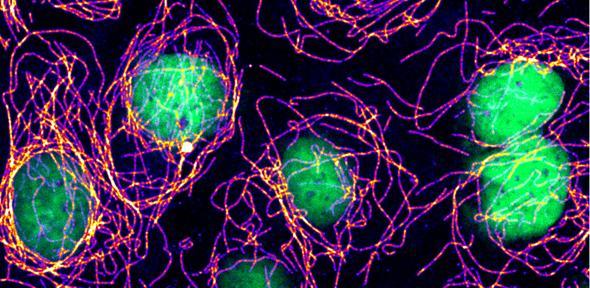
Submitted by Administrator on Thu, 06/11/2014 - 14:53
Classical genetics has typically focused on dissecting how genes or pathways control a given process within cells. However, many genes likely play roles in multiple processes, which are potentially linked to one another. Unravelling those multiple roles and links is a pressing challenge if we are to understand how healthy cells function normally as integrated systems and, conversely, how complex cellular pathologies arise in disease and how to fix them.
The October 27 2014 issue of Developmental Cell describes how Rafael Carazo Salas and his colleagues at the University of Cambridge (UK) take an important step in that direction. They report on the completion of a screen using three-dimensional microscopy image data from over 3000 different genetic mutants, which they have simultaneously analysed for defects in three fundamental cellular processes: cell shape control, microtubule organization and progression through the cell cycle.

The shape of cells is often tightly linked to their function in multicellular organisms and has been shown to be a major selection factor in evolution. Microtubules are polymers that act as a transport network within cells and influence features as diverse as cell shape, motility, division and signalling. Finally, the cell cycle governs the correct duplication and separation of genetic material between new cells and is one of the most essential and tightly regulated biological processes.
Using refined computational image analysis, the team identified 262 genes linked to those three cellular processes of which 60% has never been implicated in those processes and one third is involved in controlling more than one. The complete results of the screen can be viewed through a new online resource (www.sysgro.org) that provides direct access to all of the raw computational results used in the selection of genes and their allocation to different roles as well as many of the original images used in the study.
From the analysis several main findings emerge. There is a major, but not total, overlap between genes regulating cell shape and microtubules. Genes implicated in cell cycle regulation can be independent of cell size control. There is a complex directional interplay between specific features of cell shape control and specific features of microtubule organization (rather than a general co-deregulation of both processes as was often thought). Most exciting however is the proposal of a mechanism, conserved in humans, that suggests regulation of interphase microtubules by DNA repair factors, which has the potential to connect with previous clinical work exploring the link between microtubules and cancer progression.
References
1. A genomic multi-process survey of the machineries that control and link cell shape, microtubule organisation and cell cycle progression. Graml V, Studera X, Lawson JL, Chessel A, Geymonat M, Bortfeld-Miller M, Walter T, Wagstaff L, Piddini E, Carazo-Salas RE. Developmental Cell Vol. 31, Issue 2, p227–239, 27 October 2014. DOI: http://dx.doi.org/10.1016/j.devcel.2014.09.005
2. Dynamics of cell shape inheritance in fission yeast. Abenza JF, Chessel A, Raynaud WG, Carazo-Salas RE. PLoS ONE, September 11, 2014, DOI: 10.1371/journal.pone.0106959.

